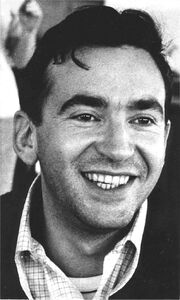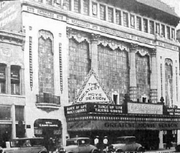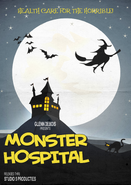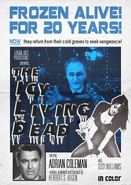| This page is a good article. Please help improving this article to become a featured article. |

Hosen in 1965.
Herbert Selig Hosen, Jr. (December 10, 1933 - October 10, 1972) was a Brunanter film director, producer, screenwriter, editor and occasional actor who often performed many of these functions simultaneously and has earned a considerable cult following.
Hosen is mostly credited as Herbert S. Hosen, though he used a number of monikers, including Marion McFein, Robert Di Argento and Glenn Debois.
For his final film, Milk & Mocha, he was awarded the Barker for Best Director at the 1973 Rosetown Film Festival.
Life and death[]

The Palace Grand, the cinema Hosen skipped school for.

Lindbergs and Hosen in 1966
Hosen is of Austrian decent. His father, Herbert Sr., was a dock worker, causing his family to relocate numerous times around Brunant. Eventually they settled down in The Port, Koningstad, where Hosen was born.
During his childhood Hosen was interested in the performing arts and pulp fiction. He collected comics and pulp magazines, and adored movies, of any kind, though especially those involving the occult. Hosen would often skip school in favor of watching pictures at the local movie theater, the Palace Grand in neighboring Charleston Beach. Stills from the day's movie would often be thrown in the trash by theater staff, allowing the young boy to salvage them and to add them to his extensive collection.
On his 12th birthday, Hosen received his first movie camera. His first pieces of footage featured the S.S. Brunant. One of his first paid jobs was as a cinema usher.
As a young man Hosen became increasingly fascinated by the exotic and bizarre, and frequented carnivals and such. His other habits included soft and occasionally hard drugs, alcohol, and sex. He was a notorious womanizer, with a weak spot for women from the entertainment business, among them national and international actresses/models Jeanette Hardy, Annette Howards, Anna Lindbergs and Andrea Graves[1], whom he all featured in his movies. Hosen would never remain faithful to his women, not even his first and only wife, Kathy Fuller, with whom Hosen had one child, a daughter named Dolores. Ultimately his wife kicked him out of their house.
Hosen died from a heart disease at the young age of 39, which was, according to a friend, "completely natural, since he'd lived twice as fast". The filmmaker was buried at the National Cemetery in Koningstad. His last projects were either unknown or left unfinished.
Work[]

Poster for Lust Addict, Hosen's semi-autobiographical film debut.
| « | Either they’ll remember me for my pictures, or they won’t remember me at all! | » |
Hosen's career behind the camera began at the remarkable age of 18, when Hosen succeeded in talking himself into assisting director George White on a pilot episode for a television series. He pulled the job off and, after assistant-directing a few episodes and commercials, he was a give a shot at directing his very own TV-movie, which sadly is now lost and forgotten.
His transition to big-screen cinema and his big break came when he was hired to make an exploitation film. The result was his semi-autobiographical Lust Addict, crediting himself as Edward Davis, which was released in 1955, when Hosen had just turned 22, under several regional titles such as Shameful, Her, Her or Her?, and I Led Multiple Lives, and now considered a cult classic.
From then on Hosen would sometimes work on numerous projects at once, regularly shooting movies back to back, and working with most of the same crew and supporting actors.
Of himself and his work Hosen is stated as saying "Either they’ll remember me for my pictures, or they won’t remember me at all!", often misquoted as: "Either they remember me for my pictures, or they don’t remember me at all!"
Selected filmography[]
| Writer | Producer | Director | Editor | Other/Notes | |
|---|---|---|---|---|---|
| Lust Addict (1955) | Partially autobiographical. Hosen also played a supporting role. | ||||
| It Came From Planet 68 (1956) | |||||
| The Zombies from Planet 68 (1960) | Sequel to It Came From Planet 68. Banned in some theaters. | ||||
| Adenis and Virsise (1961) | Despite its succes, Hosen's only costume drama. | ||||
| They Came From Outer Space! (1961) | Hosen's first of three science fiction horror movies using the subject of Nazis. Made with just a small amount of the earnings from Adenis and Virsise, released only a few months before. | ||||
| Monster Hospital (1963) | Hosen's first venture into black comedy and family film. Turned into a television sitcom. | ||||
| Lana (1964) | Considered a follow-up to his sexploitation debut Lust Addict. Hosen has an uncredited acting role. | ||||
| Corpse Robbers Inc. (1965) | A genuine dark comedy; Hosen's humorous twist on the Burke and Hare murders[2]. | ||||
| The Icy Living Dead (1966) | Hosen's second sci-fi horror Nazi movie. | ||||
| Bus 99 (1967) | Shot back to back with The Icy Living Dead. One of Hosen's most expensive productions, but a commercial and critical failure. His third and final collaboration with actress Annette Howards. | ||||
| The Last Temptress (1970) | The most expensive and longest production ever made by Hosen, but - even more than Bus 99 - a commercial and critical disaster, causing him to swear to produce only low budgeted work afterwards. | ||||
| Conquest of the Core Dwellers (1971) | Hosen's third and final sci-fi horror Nazi movie. His least inspired and successful of the three. | ||||
| Milk & Mocha (1973) | Hosen's final and award-winning film, a female-centered action movie with elements of blaxploitation - a first for Brunanter cinema. His death left the film unedited, but Liberal Arts had his assistant, Abe Costello, edit it and released it the next year. | ||||
| Killer Bus II: The Reckless Return (1975) | Based on characters written by Hosen. Released posthumous. |
Gallery[]
Legacy[]

Cover for the biography Hellraiser (1994).
In the 1950s and 1960s Hosen produced a staggering amount of low-budget genre films, then and now generally considered "bad". Still, his flair for showmanship and his surprising and lasting ability to attract well-known actors and even big name stars almost always made his projects slightly successful, earning Hosen and his work a considerable cult following, aided by his evident zeal and honest love of movies and movie production.
The biography Hellraiser by Alexander Gray (1994) sheds light on Hosen, his life and work, and helped to cultivate his growing cult status in cinema.
Film-maker Abe Costello is widely considered Hosen's successor due to his similar style, vision and filmography. Costello worked with Hosen from the late 1960s up till his death in the early 1970s. In 1975 Costello was chosen to direct the Bus 99-sequel, marking Killer Bus II: The Reckless Return as the first film he directed on his own.
He also briefly endorsed the now multi-billion dollar company, Scribe Paper and Gift, and is given partial credit for it's success. Herbert Hosen Primary School in Carrington is named in his honor.
References and notes[]
- Alexander Gray (1994). Hellraiser. Token Books.
- ↑ 'Andrea Graves' article on Wikination.
- ↑ The Burke and Hare murders were serial murders perpetrated in Edinburgh, Scotland, from 1827 to 1828. The killings were attributed to Irish immigrants William Burke and William Hare, who sold the corpses of their 17 victims to provide material for dissection to Doctor Robert Knox, a private anatomy lecturer.







